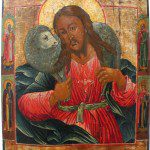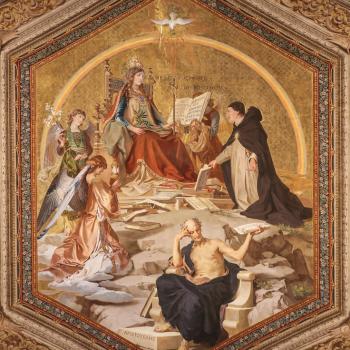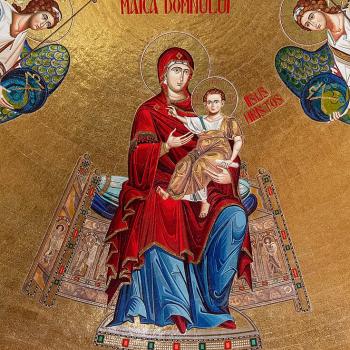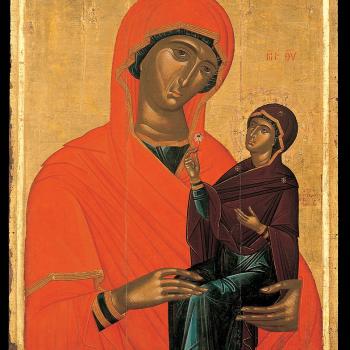![By Anonymous Russian icon painter (before 1917) Public domain image (according to PD-RusEmpire) owned by the Tretyakov Gallery [Public domain], via Wikimedia Commons.](https://wp-media.patheos.com/blogs/sites/637/2016/05/DormitionIcon-250x300.jpg)
While the typology that we have discussed which sees Mary as the New Ark of the Covenant is important and gives us a way to understand her assumption, we do not have to rely upon it to see the fittingness of the teaching and why it is important enough to be elevated to the status of a dogma. Jesus, being her son, had cause to take extra care of her, to personally take her body and soul into heaven so that she could receive her share of eternal glory. What he did in time is an expression of what he does in eternity, and so, in his honoring of his mother throughout his life (in order to fulfill the law) indicates to us the honor and respect he has chosen to give her in eternity.[1] To say Jesus did not show his mother honor or respect is to put into question whether or not he is the messiah, because it would be indicative of him disrespecting not only his mother, but the eternal law of God.[2] Therefore, as he honored her in her life, so he exemplified that honor and completed it in her assumption.
Mary, as we have seen, was given the grace which allowed her to be born pure and without sin. This grace came to her so that she could fulfill in herself God’s intention with Israel, as Vladimir Lossky also explained:
The whole development of the Old Testament, with its successive elections – the election of Noah, the election of the stock of Abraham, the election of the people of Israel, the election of the tribe of Judah, the election of the House of David, the law which preserved the purity of the people of God, the blessing on the chosen descendants, the whole of this sacred history appears as a providential and Messianic process, as a preparation of the Body of Christ, of the Church – the very focal point of union with God, and above all as a preparation of Her who was to lend her human nature so that the mystery of the incarnation could be realized.[3]
In and through Mary, God’s preparation of humanity for the incarnation, accomplished in and through Israel, was made complete. She lived a pure and holy life, a life of loving service to God, which produced in her a spiritual beauty second to none. As her gift of love, she put herself totally at God’s discretion, which he willingly accepted as he made her his chosen vessel for the incarnation. This is how God the Word chose her immaculate flesh to be joined with his divinity and be the source by which he was to become human. This means that his flesh is so intricately united to hers that it would be a scandal if she had not been assumed into heaven, that is, if her body had been left to corruption here on earth. It would have been a sign that such corruption was to be found in Christ’s own flesh. And this is exactly what St. Paul said God would not have let happen: “but he whom God raised up saw no corruption” (Acts 13:37). Her assumption into heaven should therefore be understood as the final act of God’s preservation of Christ’s flesh.
We can find more reasons why Mary’s assumption is a fitting end to her temporal life than we have the need to explore here. For example, in one of the earliest homilies we have on the dormition, preached by Theoteknos of Livias, we can read one such explanation by seeing how her glory is compared to that of Enoch and Elijah:
The holy one was pleasing to God the Father; the virgin was pleasing to the substantial Word, begotten from the Father before the ages; the virgin was pleasing to the life-giving Spirit, who gives every being light and transforms them into citizens of heaven. For if Enoch, who pleased God, was taken up “that he might never see death” (Gen 5:24; Heb 11:5), how much more would God have taken up the soul of her whom he had made one body with divine grace, to the paradise of delight where the divine light shines without end! And if he commanded that Elijah, who was a prophet, should mount to heaven in a chariot of fire (1 Kg 2:11), how much more she who is foretold and called blessed in the prophets’ writings, who shines in an outstanding way among the prophets and the apostles like the moon in the midst of the stars.[4]
Mary, full of grace, had her flesh and blood filled with grace, and this freed her from the corruption surrounding death. It is the grace which is to be had for all who find themselves perfectly united to the deifying grace of God – it is the grace of the resurrection. All who are raised in glory shall receive incorrupt bodies. But we see this grace is given to Mary in a special way because of her intimate connection with her son, Jesus. She received the first share of the glorification of humanity which Jesus offers to all thanks to his death and resurrection. In her person we find the bridge between the God-man and us, just as Jesus was in his person the mediator between humanity and God. Her flesh, her humanity, is connected to and united with the flesh and blood of Jesus, so that as he had ascended into heaven, he fulfills that ascent by taking her with him.
Mary was, as it were, lifted up in a royal procession, similar to the enthronement of kings in Israel, where the queen was known to follow after and receive a share of the glory of the king. This celebration was the foundation for Psalm 45, where now, we can understand Jesus is the king of glory who has taken his place upon the eternal throne, his humanity anointed by the Holy Spirit (Ps. 45:1-9). Mary finds her place to right, where, as the Psalm said, “stands the queen in gold of Ophir.” (Ps. 45:9b RSV). Thus, while Psalm 45 is often used to demonstrate both the humanity and divinity of Christ,[5] the king, it also turns its attention upon the queen who stands to his right, the queen-mother Mary. For, as we have said before, Mary presents a necessary component of Christology as she is the one who connects Jesus to the rest of humanity. And when when he is glorified in his royal ascent into heaven, Mary receives a share of that glory as she finds her place next to him. She is elevated by him and praised by all generations for the glory which the king has given unto her:
The princess is decked in her chamber with gold-woven robes; in many-colored robes she is led to the king, with her virgin companions, her escort, in her train. With joy and gladness they are led along as they enter the palace of the king. Instead of your fathers shall be your sons; you will make them princes in all the earth. I will cause your name to be celebrated in all generations; therefore the peoples will praise you for ever and ever (Ps. 45:13-17 RSV).[6]
In her assumption, Mary, Daughter Zion, is taken up into heaven. She finds her place next to the king, Christ her son. In this way, she can be said to be crowned with glory. God the Word, her son, has caused her name to be glorified, and this is not because he merely imputes righteousness to her but because in and through her life she has proven herself worthy of that praise. She said yes to God and no to Satan; she completely gave herself to God with a pure a holy love. And God, in seeing her, saw his preparation for the incarnation had come to an end. His grace came to her and made her the New Eve. He accepted her offer of herself and took from her what he needed so as to become incarnate on earth. From birth to death, she lived her life in total dedication to God, and so in her death, she was received into glory, and now is to be praised for that glory in eternity. For through her God’s glory is perfectly reflected: he is the sun of righteous (cf. Mal. 4:2) while she is the woman clothed in his grace, the woman clothed in the sun.
To Be Continued
[1] Just as the economic Trinity is the immanent Trinity, so we find, the actions of Jesus in time, in the economy of salvation, is indicative of the person and what he does in eternity.
[2] And therefore, he would be a sinner, which would disqualify him from not only being the messiah but also as being God, for God cannot sin.
[3] Vladimir Lossky, The Mystical Theology of the Eastern Church. trans. Fellowship of St. Alban and St. Sergius (Crestwood, NY: St. Vladimir’s Seminary Press, 2002), 140. We have explored this point before, but because of how it connects to our interest here, Lossky helps us bring the focus back to where it needs to be: the relationship between Mary and the history which led to the incarnation. This point is fundamental if we are going to understand the glory God shown to Mary.
[4] Theoteknos of Livias, “An Encomiun on the Assumption of the Holy Mother of God” in On the Dormition: Early Patristic Homilies. trans. Brian E. Daley, S.J. (Crestwood, NY: St Vladimir’s Seminary Press, 1998),73-4.
[5] Cf. Ps 45:7, where the anointed one is called God. The divine person, God the Word, is anointed in accordance to his humanity.
[6] Therefore, Mary saying all generations shall call her blessed (cf. Luke 1:43) indicates that she shall fulfill the type presented of the queen in Psalm 45.
Stay in touch! Like A Little Bit of Nothing on Facebook:
A Little Bit of Nothing












